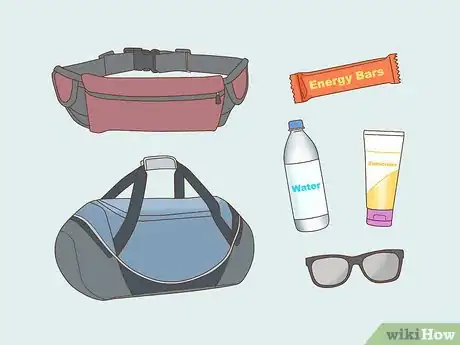This article was co-authored by Francisco Gomez. Francisco Gomez is the Head Coach at the FIT Potato Gym, a training gym established in 2001 in the San Francisco Bay Area. Francisco is a former competitive runner who helps endurance athletes train for major marathons like the Boston Marathon. Francisco specializes in Injury Rehab, Flexibility, Marathon Training, and Senior Fitness. He has a B.S. in Nutrition and Exercise Physiology & Running.
There are 8 references cited in this article, which can be found at the bottom of the page.
wikiHow marks an article as reader-approved once it receives enough positive feedback. In this case, 100% of readers who voted found the article helpful, earning it our reader-approved status.
This article has been viewed 449,142 times.
Running a marathon is a remarkable athletic achievement. Whether you're a world-class runner or a beginner, running a marathon is a serious commitment. Training is an essential, long-term process, so give yourself at least 3-6 months to gradually build your endurance, or longer if you're not already in good running shape. Your body will need lots of fuel, so eat a high-carb, high-protein diet, and drink plenty of fluids to stay hydrated. Above all, remain positive, have fun, and be proud of yourself for taking on this intense challenge!
Steps
Developing a Training Program
-
1Begin training at least 16-24 weeks before the marathon. Register for the marathon and start training at least 6 months before race day. Even for experienced athletes, running a marathon requires lots of preparation, and proper training is a key part of injury prevention.[1]
- Keep in mind you should already have experience with long-distance running before attempting a marathon. Marathon training plans generally assume you already run 3 times per week and can run for around 10 miles (16 km) at a time.
- Specific requirements vary by race. In general, you need to be able to run a total of 15 to 25 miles (24 to 40 km) per week and have previously run 5K and 10K races. Some races also have minimum qualifying times.[2]
- If don’t regularly run long distances, check with your doctor before starting a new exercise routine.
EXPERT TIPTyler Courville is a brand ambassador for Salomon Running. He has run in 10 ultra and mountain races across the United States and Nepal, and won the 2018 Crystal Mountain Marathon.Professional Runner
 Tyler Courville
Tyler Courville
Professional RunnerFinding friends to train with can help you get stick to a plan. I really like finding people to run with, so it not only keeps you accountable, but it gives you something to look forward to. It's much better than a checklist on your fridge — there’s a person on the other end.
-
2Run 3 training sessions per week with alternating difficulties. There are a variety of marathon training plans, but they share a few basic elements. To increase your stamina gradually and avoid injury, run 3 times per week with a rest day between each session. Do a long distance run just once a week, and focus on speed and pacing on the other days. For instance:[3]
- Tuesday: Run a total of 8 alternating 200 m to 400 m intervals at jogging and sprint speeds. Your target intensity for speed day is 80 to 100% of your max heart rate.
- Thursday: Run at a brisk, mid-tempo pace, starting at 3 miles (4.8 km) in the first week of training. Your target intensity is about 70% of your max heart rate.
- Saturday: Run a slow-tempo pace, starting at 10 miles (16 km) in the first week of training. For long run day, your target intensity is about 60% of your max heart rate.
- To calculate your max heart rate, subtract your age from 220. Wear a fitness monitor to keep track of your heart rate as you run.[4]
- Try to build up your stamina by no more than 10% per week,in time or in miles.[5]
Advertisement -
3Warm up and cool down before and after your runs. Walk briskly or jog lightly for 5 to 10 minutes to get your body ready for exercise. After a run, walk or jog for another 5 to 10 minutes to ease your body back to a resting state.[6]
- Warming up and cooling down can help prevent injury and leg cramps. Stretching your legs after a run can also help your muscles recover.[7]
Tips to avoid injury: Wear well-fitting running shoes and comfortable socks. Avoid running or exercising the same muscle group 2 days in a row. Always listen to your body, and don’t try to push through pain.
-
4Increase your distances by 10% to 20% per week for about 10 weeks.[8] Increasing distances too quickly is a common mistake. Instead, run at each tempo for gradually longer distances. For instance, add 1 to 2 miles (1.6 to 3.2 km) to your long day until you can run for 20 to 22 miles (32 to 35 km).[9]
- If you miss a training session, don’t try to run on back-to-back days. If you miss a week, don’t try to double up your distances the next week.
- Every month or so, go easy on yourself and run the distances you ran in week 1. Your body will need extra recovery time as you increase the time you spend on your legs.[10]
-
5Enter 5K, 10K, and half-marathon races during training. Running shorter races can help you learn what to expect on an actual race day. Look online for races and incorporate them as long run days in your training program.[11]
- Don’t run more than 3 half-marathons in a 6-month period and don’t run any races within 3 weeks of the marathon.
- Incorporating shorter events in your program will help you know what to expect on race day. From check-in logistics to adrenaline rushes, races involve variables that you can’t plan for simply by running on your own.
-
6Decrease your distances by 25% to 50% per week in the last 3 weeks. Taper your training sessions toward the end of the program so you’ll be fully recovered and ready for the big day. Marathon training plans are usually at least 16 weeks; your longest run should take place around week 13. Scale down weeks 14 and 15, then do 1 to 2 light 15 to 30-minute runs during week 16.[12]
- For example, if you got to a peak long day run of 22 miles (35 km) in week 13, run 15 miles (24 km) on long day in week 14, and 10 miles (16 km) in week 15.
- Don’t run the day before the race. Remember to keep your runs light during week 16.
Fueling Your Body
-
1Refuel with a healthy snack or meal within 15 minutes after a run. To promote muscle recovery, eat right after you’ve finished running. That goes for training sessions and the big race. Go for high-carb or high-protein items, such as fruit, yogurt, whole grain bread, brown rice, legumes, poultry, and fish.[13]
- Never go more than 90 minutes after a run without eating. Your muscles refuel most efficiently soon after strenuous activity.
-
2Maintain a diet packed with complex carbohydrates during training. Healthy, high-carb foods should comprise about 60 to 70% of your diet. For a 2500 calorie diet, that means you should consume 1500 to 1750 calories, or about 375 to 440 grams of carbs per day. Good sources of complex carbs include fruits, veggies, beans, brown rice, and whole grain bread and pasta.[14]
- High-carb options could include a whole grain bagel with egg and cheese for breakfast, a whole grain pasta salad for lunch, pieces of fruit and nuts for snacks, and sides of brown rice and steamed veggies at dinner.
- Complex carbs supply your muscles with glycogen, which is a substance your body uses to store energy and deliver it to muscles.
-
3Eat at least 4 to 6 ounces (110 to 170 g) of protein per day. Go for lean protein sources, such as poultry, fish, and legumes. As a rule of thumb, runners require about 1.5 grams of protein per kilogram of body weight (about 0.7 grams per pound).[15]
- For example, a runner who weighs 170 pounds (77 kg) would need about 4 ounces (119 grams) of protein per day. A 6 ounce (170 g) serving of chicken breast, a 5 ounce (140 g) salmon fillet, 1 cup (172 g) of steamed soybeans, and 2 large eggs would meet that daily need.
- Overlooking protein requirements is a common mistake among runners. Protein is needed for muscle strength and durability. Many protein-rich foods also contain iron, and consuming too little iron leads to muscle fatigue.
-
4Monitor your urine to make sure you’re staying hydrated. As a rule of thumb, try to drink about at least 8 cups (1,900 mL) of fluids per day. The exact amount you need to drink depends on a variety of factors, and your urine is the best way to gauge your hydration level. You’re hydrated if it’s light in color, and you’re dehydrated if it’s darker.[16]
- During a run, aim to drink about 1 cup (240 mL) every 15 to 20 minutes. Never wait until you’re thirsty to drink; if you’re thirsty, you’re already dehydrated.
Tip: Practice drinking out of a cup or bottle while you're running. Additionally, find out which beverages (such as a certain flavor of sports drink) will be provided on race day. Drink that beverage when you train to get used to it.[17]
-
5Consume a healthy meal and 2 cups (470 mL) of fluids before the race. To hydrate your body on race day, drink 2 cups (470 mL) of water or a sports drink 2 hours before the race's start time. An hour before the race, eat a 300-calorie, high-carb, low fat meal to boost your energy reserves.[18]
- For example, have a whole grain bagel with peanut butter and a banana or pasta with chicken and zucchini.
- Be sure to avoid items that might upset your stomach. If, for instance, dairy products give you trouble, steer clear of yogurt, milk, or cheese on race day.
Running a Successful Race
-
1Get plenty of sleep during the week of the marathon. Do your best to sleep for at least 7 to 9 hours of sleep each night leading up to the race. You might be anxious or excited the night before the race and find it hard to sleep. If you get plenty of rest in the days prior, a restless night before the race will have less of an impact.[19]
- Set aside 1 to 2 hours before bed to do a relaxing activity, like reading or listening to soothing music. Do your best to keep your mind off of the race, day-to-day responsibilities, and any other sources of anxiety.
- Keep your room quiet and dark and, if possible, set the temperature to around 68 °F (20 °C).
- Don’t drink caffeine in the evening, and avoid eating a heavy meal within 3 to 4 hours of going to bed. Before bedtime, have a healthy snack packed with complex carbs, like cheese and whole grain crackers, whole grain cereal, or a banana.
-
2Check the weather forecast and dress appropriately. If it'll be cold, dress in layers that you can remove as necessary. In hot weather, wear breathable, lightweight, and light-colored clothing.[20]
- Go for moisture-wicking fabrics, especially if it's chilly. Avoid fabrics that trap moisture, such as cotton. Trapped moisture in cool weather can give you the chills.
- If you need to shed layers on the run, wear clothing that you're okay with losing or leaving by the side of the road. It's a good idea to ask loved ones to stand at designated spots in case you need a quick change of clothes or socks.
-
3Pack a runner's belt and bag with your essentials. Assemble energy bars or gels, water, sunscreen, your fitness monitor (if you use one), sunglasses, a change of clothes, and any other necessities the night before so you’re not scrambling on race day. Pack items that you'll need on you during the race, such as the fitness monitor and energy packets, in the belt. Store supplies you'll need before and after the marathon in a bag or backpack.[21]
- If necessary, make arrangements with a friend or relative to hold onto your stuff while you run.
- Check the marathon website beforehand and make sure bags are allowed. You may only be allowed to store items in a clear plastic bag.
-
4Arrive at the race early and check in as directed. To keep your nerves in control, wake up early and give yourself plenty of time to eat, get to the check-in area, and mentally prepare yourself for the race. Give yourself at least 15 to 30 minutes extra time to account for traffic, trouble parking, or other variables. When you arrive, head to the designated check-in area to register and receive your number.[22]
Plan ahead: Scout out the course in advance to familiarize yourself with the terrain. Drive or cycle the course, find the check-in area, and look for spots along the second half of the race where loved ones could stand and give you a pep talk, snack, or fresh pair of socks.[23]
-
5Pace yourself, especially during the first 10 miles (16 km).[24] Your adrenaline levels will spike on race day, and that rush can cause you to push too hard at the start. Use your excitement to stay motivated, but keep it under control. Remain conscious of your pacing, check your heart rate, and hold back in the first half of the race to conserve energy.[25]
- During training, you’ll get a feel for the length of time you can stay on your legs and the pace you need to keep in order to stay in the race.[26] Track your minutes per mile or kilometer closely to stay on target.
- For the average runner with a goal to finish in 4 hours, the target pace in the first half of a marathon is 8 minutes and 30 seconds (5:16 per km).
-
6Slow your pace toward the end of the race to avoid overexertion. Try to maintain your pace or slow it a bit up to mile 20 (32 km). Then slow down 30 seconds to a minute to push through the last leg. If, for instance, you're aiming for a 4-hour time, try to run at 9 minutes 30 seconds per mile (5:54 per km) from mile 20 (32 km) until the finish line.[27]
- Additionally, make sure you've fueled up with energy bars or gels by the race's midpoint. If you don't eat something until mile 18 (29 km), you'll crash by mile 20 (32 km).
-
7Use positive visualizations to stay motivated. Keep your goal in mind, picture yourself crossing the finish line, and imagine the joy and pride you’ll feel. Channel energy from spectators and use their cheering to push forward. If you feel like you're hitting a wall, stay positive and visualize yourself blasting through it.[28]
- Above all, have fun. Enjoy the challenge, and take pride in the fact that you’re pushing yourself to your limits!
Expert Q&A
-
QuestionHow do I run without getting bored?
 Francisco GomezFrancisco Gomez is the Head Coach at the FIT Potato Gym, a training gym established in 2001 in the San Francisco Bay Area. Francisco is a former competitive runner who helps endurance athletes train for major marathons like the Boston Marathon. Francisco specializes in Injury Rehab, Flexibility, Marathon Training, and Senior Fitness. He has a B.S. in Nutrition and Exercise Physiology & Running.
Francisco GomezFrancisco Gomez is the Head Coach at the FIT Potato Gym, a training gym established in 2001 in the San Francisco Bay Area. Francisco is a former competitive runner who helps endurance athletes train for major marathons like the Boston Marathon. Francisco specializes in Injury Rehab, Flexibility, Marathon Training, and Senior Fitness. He has a B.S. in Nutrition and Exercise Physiology & Running.
Fitness Coach Find places you love! If you like nature, then find a nice part that you find scenic. Also, invite a friend that you enjoy being around and don't mind talking to for a certain period of time when you're running. This will make your training more engaging.
Find places you love! If you like nature, then find a nice part that you find scenic. Also, invite a friend that you enjoy being around and don't mind talking to for a certain period of time when you're running. This will make your training more engaging. -
QuestionI want to run a marathon. How I find one to sign up for?
 Community AnswerGoogle "marathons near me". Make sure you give yourself several months to train, depending on your level of fitness.
Community AnswerGoogle "marathons near me". Make sure you give yourself several months to train, depending on your level of fitness. -
QuestionHow can I catch my breath during a marathon when I am exhausted?
 Community AnswerIf you don't want to stop running, it's hard to fully regain your breath. You can focus on the act of breathing, pulling air in through your nose and out through your mouth, and try to slow your heart rate that way. If you're really winded, try reducing your speed to a slow jog or even walking a short stretch until you feel better.
Community AnswerIf you don't want to stop running, it's hard to fully regain your breath. You can focus on the act of breathing, pulling air in through your nose and out through your mouth, and try to slow your heart rate that way. If you're really winded, try reducing your speed to a slow jog or even walking a short stretch until you feel better.
Warnings
- Remember to build your endurance gradually.[36] If you’re not used to strenuous activity or long-distance running, consult your doctor before you begin training.⧼thumbs_response⧽
- Never ignore or try to push through pain, swelling, redness, or any other signs of injury. To avoid a chronic injury or complications, see a doctor promptly if you experience any concerning symptoms.⧼thumbs_response⧽
References
- ↑ https://marathon.harvard.edu/articles/The_Less-Is-More_Marathon_Plan.pdf
- ↑ https://www.ucsfhealth.org/education/running_a_marathon_training_tips/
- ↑ https://marathon.harvard.edu/articles/The_Less-Is-More_Marathon_Plan.pdf
- ↑ https://www.heart.org/en/healthy-living/fitness/fitness-basics/target-heart-rates
- ↑ Francisco Gomez. Fitness Coach. Expert Interview. 24 October 2019.
- ↑ https://www.upmc.com/services/sports-medicine/for-athletes/marathon-running/training
- ↑ Francisco Gomez. Fitness Coach. Expert Interview. 24 October 2019.
- ↑ Francisco Gomez. Fitness Coach. Expert Interview. 24 October 2019.
- ↑ https://marathon.harvard.edu/articles/The_Less-Is-More_Marathon_Plan.pdf
- ↑ http://www.ucdenver.edu/academics/colleges/medicine/sportsmed/cusm_patient_resources/Documents/Marathon%20Training%20Tips.pdf
- ↑ http://www.ucdenver.edu/academics/colleges/medicine/sportsmed/cusm_patient_resources/Documents/Marathon%20Training%20Tips.pdf
- ↑ https://www.ucsfhealth.org/education/running_a_marathon_training_tips/
- ↑ http://www.ucdenver.edu/academics/colleges/medicine/sportsmed/cusm_patient_resources/Documents/Marathon%20Training%20Tips.pdf
- ↑ http://www.ucdenver.edu/academics/colleges/medicine/sportsmed/cusm_patient_resources/Documents/Marathon%20Training%20Tips.pdf
- ↑ http://faculty.washington.edu/crowther/Misc/RBC/protein.shtml
- ↑ https://www.ucsfhealth.org/education/running_a_marathon_race_day_success/
- ↑ https://www.upmc.com/services/sports-medicine/for-athletes/marathon-running/training
- ↑ https://www.ucsfhealth.org/education/running_a_marathon_race_day_success/
- ↑ http://www.ucdenver.edu/academics/colleges/medicine/sportsmed/cusm_patient_resources/Documents/Marathon%20Training%20Tips.pdf
- ↑ http://www.ucdenver.edu/academics/colleges/medicine/sportsmed/cusm_patient_resources/Documents/Marathon%20Training%20Tips.pdf
- ↑ http://www.ucdenver.edu/academics/colleges/medicine/sportsmed/cusm_patient_resources/Documents/Marathon%20Training%20Tips.pdf
- ↑ https://www.ucsfhealth.org/education/running_a_marathon_race_day_success/
- ↑ http://www.ucdenver.edu/academics/colleges/medicine/sportsmed/cusm_patient_resources/Documents/Marathon%20Training%20Tips.pdf
- ↑ Francisco Gomez. Fitness Coach. Expert Interview. 24 October 2019.
- ↑ https://www.ucsfhealth.org/education/running_a_marathon_race_day_success/
- ↑ Francisco Gomez. Fitness Coach. Expert Interview. 24 October 2019.
- ↑ https://www.ucsfhealth.org/education/running_a_marathon_race_day_success/
- ↑ https://www.upmc.com/services/sports-medicine/for-athletes/marathon-running/training
- ↑ https://www.upmc.com/services/sports-medicine/for-athletes/marathon-running/training
- ↑ http://www.ucdenver.edu/academics/colleges/medicine/sportsmed/cusm_patient_resources/Documents/Marathon%20Training%20Tips.pdf
- ↑ https://www.ucsfhealth.org/education/running_a_marathon_training_tips/
- ↑ https://www.ucsfhealth.org/education/running_a_marathon_training_tips/
- ↑ http://www.ucdenver.edu/academics/colleges/medicine/sportsmed/cusm_patient_resources/Documents/Marathon%20Training%20Tips.pdf
- ↑ http://www.ucdenver.edu/academics/colleges/medicine/sportsmed/cusm_patient_resources/Documents/Marathon%20Training%20Tips.pdf
- ↑ http://www.ucdenver.edu/academics/colleges/medicine/sportsmed/cusm_patient_resources/Documents/Marathon%20Training%20Tips.pdf
- ↑ Francisco Gomez. Fitness Coach. Expert Interview. 24 October 2019.
About This Article
To run a marathon, start training at least 3 months before race day to help you increase your stamina gradually. Taper your training sessions by 25% to 50% per week in the last 3 weeks so you’ll be fully recovered and ready for the race. On race day, remember to pace yourself, especially during the first 10 miles, to avoid depleting all of your energy. Use positive visualizations to stay motivated as you make your way toward the finish line! For tips on adjusting your diet to accommodate your training program, read on!





















-Step-17-Version-2.webp)



















-Step-17-Version-2.webp)



































